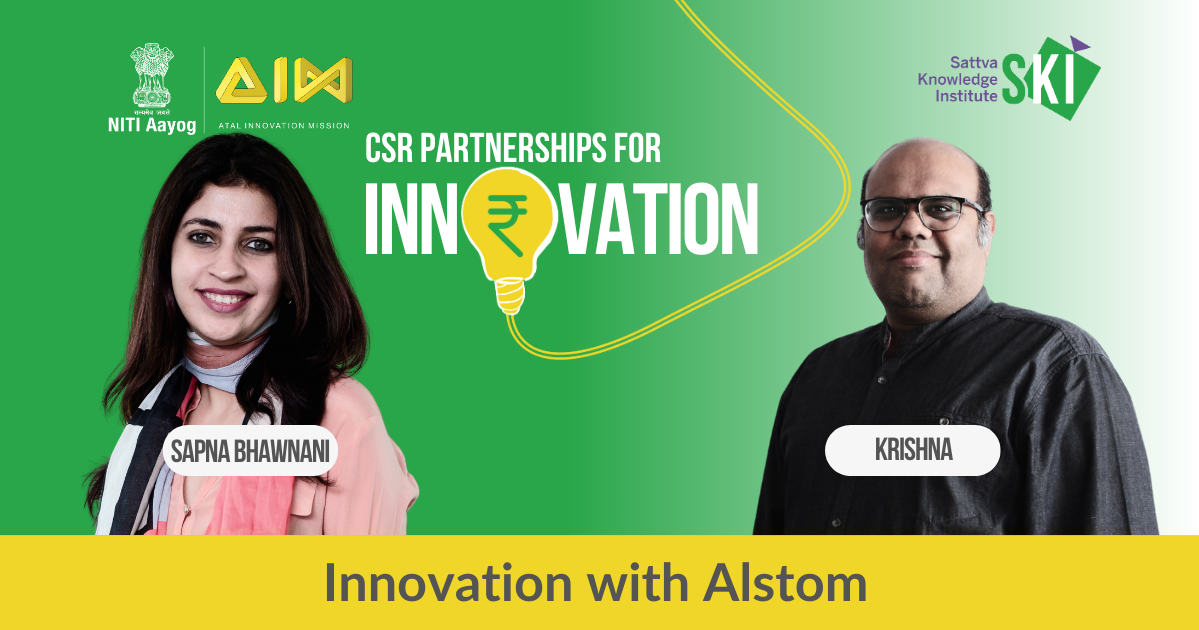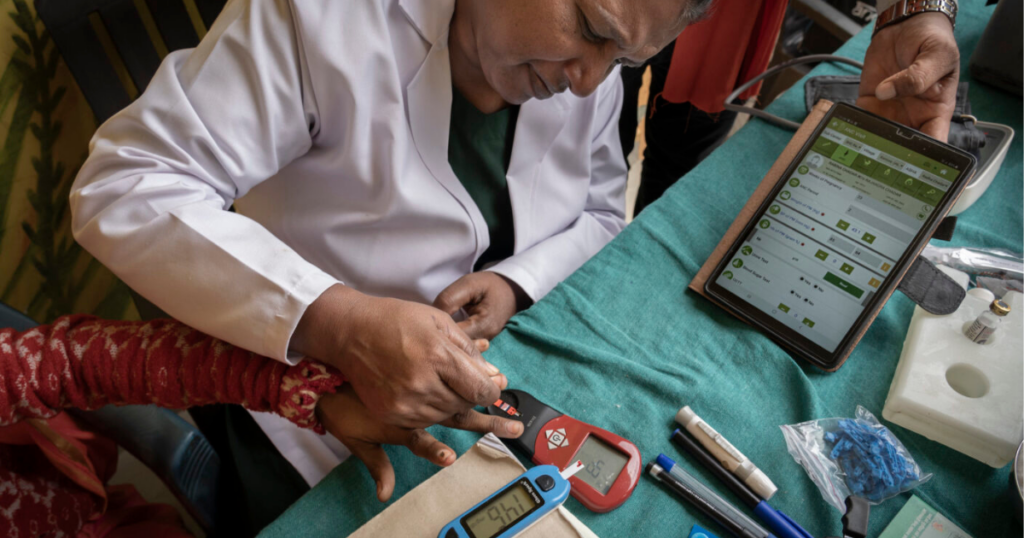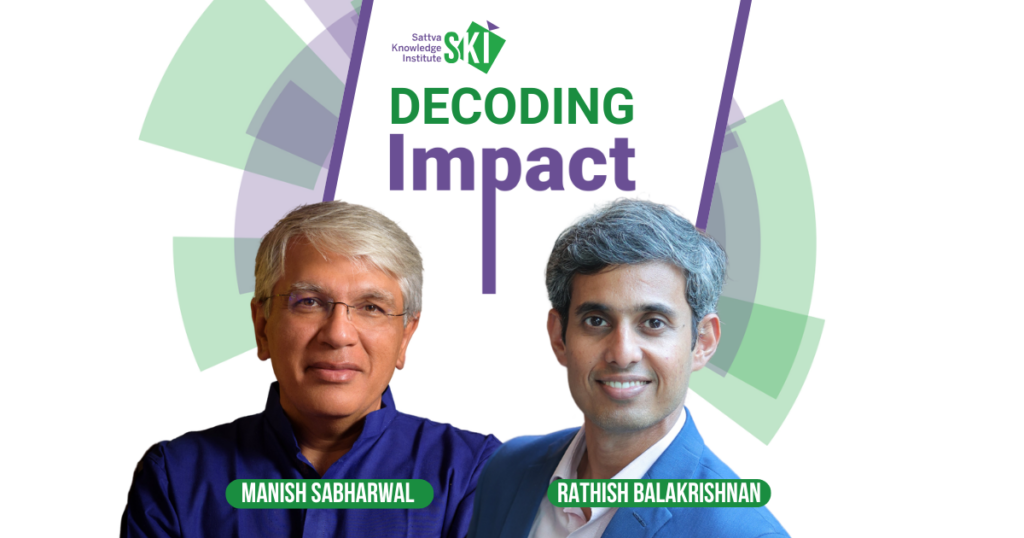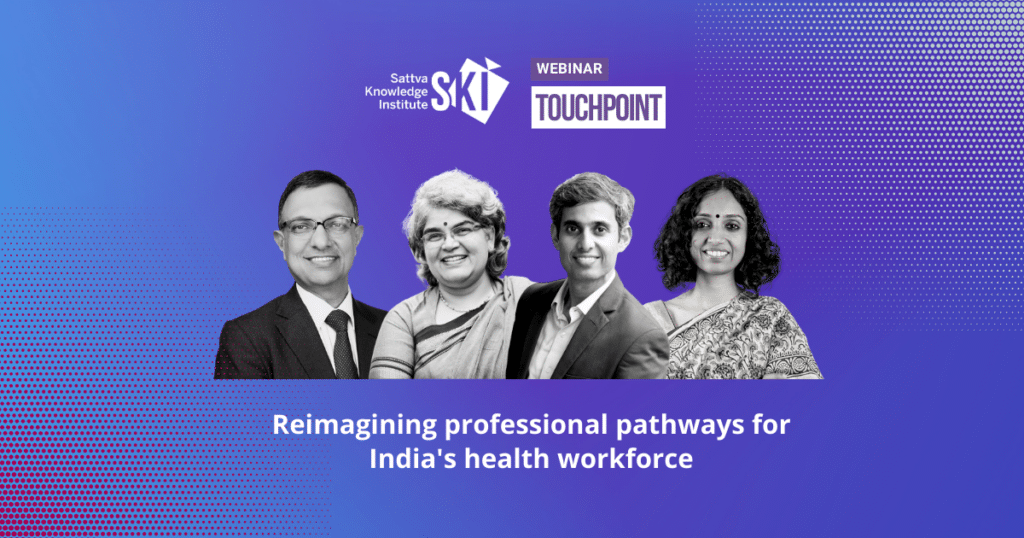


In this episode, Krishna speaks with Sapna Bhawnani from Alstom, an organisation at the forefront of driving innovation in India’s sustainable mobility sector. Sapna has played a pivotal role in shaping Alstom’s CSR strategy in India, and she shares her incredible journey to foster innovation, her personal learnings, as well as ideas for others looking to integrate innovation as part of CSR.
Sapna currently leads Communications & CSR of the Asia Pacific Region at Alstom. She has been associated with Alstom in various capacities in India and internationally since 2008.
Episode Transcript
Introduction: Welcome to the podcast ‘CSR Partnerships for Innovation’. I am Chintan Vaishnav, Mission Director for Atal Innovation Mission at the Niti Aayog, and we are delighted to unveil this podcast series in collaboration with Sattva Consulting, hosted by their dynamic and hands-on CEO Srikrishna Sridhar Murthy. We are excited to embark on this journey with you as we navigate the fascinating realm where innovation meets CSR. So, thank you for tuning in, hope you enjoy it.
In a world driven by innovation and fuelled by entrepreneurial spirit, India has emerged as a vibrant hub for cutting-edge ideas and groundbreaking initiatives. From villages to large metropolitans, the country is witnessing a remarkable surge in start-ups and innovation-focused ventures across diverse sectors. Innovation, when channelled properly, can create a large-scale societal impact. India has also been home for one of the most active CSR ecosystems, thanks to the regulation in CSR that was introduced a few years ago. We believe CSR can play a very important role in fuelling the innovation towards societal change and we hope to explore how the CSR ecosystem and the world of innovation are coming together to build a better India.
Srikrishna Sridhar Murthy (SM): [00:01:40] Today, we have a special guest who has been at the forefront of driving innovation in India’s sustainable mobility sector. Joining me is Sapna Bhawnani, who has played a pivotal role in shaping Alstom’s CSR strategy in India. In today’s podcast, Sapna will walk us through her incredible journey in fostering innovation, her personal learnings as well as ideas for others looking to integrate innovation as part of CSR. Sapna Bhawnani is currently leading communications and CSR of the Asia Pacific region at Alstom. Ms Bhawnani has been associated with Alstom in various capacities in India and internationally since 2008. Sapna, welcome to today’s episode. It’s wonderful to have you here. It’ll be great if you can start us off by introducing yourself, the work that Alstom does in India and also how you got involved with CSR personally.
Sapna Bhawnani: [00:02:40] Thank you very much for having me, Krishna. It’s a pleasure to be here with you, to speak about Alstom and what we do in the space of innovation and CSR. I currently lead communications and CSR for the Asia Pacific region at Alstom. The Asia Pacific region, of course, you know India is a large part of that. It’s our largest – we’ve got about 10,000 employees in India alone. So, it’s a fairly large cluster within the region. Now, if you’ve used a metro anywhere in Delhi, Lucknow, Kochi, Chennai, then the likelihood that this metro has actually been built by Alstom is very high. Pretty much every train, every metro car in the country has something small that comes from Alstom. So we’re the largest company in the country in the sustainable mobility space. Now coming to what we do in CSR, let’s start a little bit with how I came to lead the CSR portfolio for the company. The company has a philosophy that in any country where we are more than 200 employees, we definitely have community action plans because, you know, as a responsible company, we want to give back to communities. So India always has had a country community action plan. We’re the only country in the globe that has CSR laws and legally mandated spending. That didn’t kick in for us up until 2020. But until then, like we were doing these small charitable actions and back in 2016, you know, one of our largest factories in Madhepura started taking shape. We had a very rural community, seven villages in and around the facility that had given up land for actually this factory to come into place. So obviously there was commitment and intent from the company to contribute to these communities, and at that point in time, I raised my hand and said that I want to lead this particular project and CSR for the country. I’ve always been interested in giving back to society, but quite honestly, up until then, I hadn’t really done anything meaningful and given that part of my job anyways, involves establishing Alstom’s reputation as a company that truly cares and is purposeful, wants to do well for the community in which it operates. I think it was a no-brainer that, you know, the two portfolios could sit with me, and since then I’ve been leading the mandate for the company.
SM: [00:05:09] Well, that’s wonderful, and I think I’m sure most of us very fondly remember train journeys or metro journeys in the cities that you talked about. As CSR has evolved in the country, we’ve also seen diversification of what CSR is doing. I’m sure Alstom in India also focuses a lot on R&D – research and innovation are important if you’re the largest contributor to sustainable mobility. So how did the thought or the the thinking around having innovation as part of your CSR portfolio arise, it’ll be great to also understand how the company reacted to it. What were the conversations like in the board? I’m sure you had some compliance people to convince, some auditors to kind of get through and all of that stuff, so it’ll be great to hear that part of the journey.
SB: [00:06:01] Okay, so Krishna, before we come to I think innovation as a part of CSR, I want to talk a little bit about the innovation culture at Alstom. We are a manufacturing company. We’re a company that’s largely built off engineers, right? So, innovation is pretty much central to the company’s DNA, innovation is what’s brought Alstom to where we are today, and innovation is what will take us into the future of mobility. Now, as a company, we don’t think innovation is something that’s limited to experts. You know, the process is open to all Alstom employees and even to external innovation partners. We’ve got a number of open innovation programmes that run internally. We are often having employees take part in innovation challenges, where they come up with interesting ideas, interesting solutions and mobility that are going to make a difference to how the world travels more sustainably in the future. I know these are the kind of projects that the company is happy to invest R&D money into, right? So we’ve got a number of internal start-ups that we fund. We have incubation cells internally, we are working with ecosystem partners, we’ve got innovation kiosk, you know, for the Asia Pacific region. We just started an innovation station in Singapore last year. So there’s plenty the company does in the innovation space and is very used to working with start-ups. So frankly, I think working in the innovation space or investing in start-ups was not a new concept for Alstom.
SB: [00:07:39] Guess what’s new is funding it via the CSR route, which is very specific to India. Now obviously innovation is required in terms of commitment and funds. It needs a certain scale. I mean, India is the third largest start-up capital in the world. There’s so much happening in this space. So to invest in this ecosystem in the country was an absolutely no-brainer for us, right? So in 2020, when we had the funds, we just fast-tracked that whole decision-making for us. So quite honestly, I actually did not face much resistance at all. The time that it took was to initiate a few conversations that Sattva assisted us with, with IITs, IIMs, both these institutes had mobility projects that they were running already. I think what my compliance team needed to understand was that the laws allow this, you know what the process would be, whether we actually own any of the patents and all of that. So obviously, the internal education was an understanding how funding incubators actually work via the CSR route. Once that was done, I think getting the buy-in and committing the funds to do this in the sustainable mobility space was quite smooth sailing, I would say, Krishna.
SM: [00:08:58] So basically the focus was really the ‘how’. The ‘what’ was already, you know, in some sense ‘why’ and ‘what’ was sold. If we figured out the ‘how’, then it became a little more of a smooth sail. So from there on, Sapna, how did the programme evolve? I know you’re working with Bangalore quite deeply. Tell us a little bit about what that programme is all about, what you hope to achieve and as a company which is committed to CSR and societal good, what are the outcomes that would make you in some sense proud, both from a societal point of view and from a company perspective.
SB: [00:09:34] Right. So let’s come back to Alstom’s core vision Krishna, which is we are leaders in innovation and the sustainable mobility space, right? We want to accompany the pivot and the movement to rail as the preferred and the most sustainable means of transport. Now transport as a sector is one of the largest contributors to worldwide carbon emissions. Now, obviously, within that, rail is the solution that produces the least emissions, right? But, we did a survey recently, and we were very surprised to find that even in Europe or France, where the public transportation network is actually so well built, people still prefer to kind of use their cars, and as a company, we want to make sure that we promote the advantages of using rail as a solution. We want people to actively choose train as a preferred mode of transport. It’s good for them. It’s good for the environment, right? I think with that as the core vision of the company, you know, when we started evaluating, like how can our societal investments be more connected to the brand’s core purpose? I think investing in the sustainable mobility space was the obvious answer. We’ve seen the research in India, Krishna, that Sattva assisted with as well that the problems are the same, right? The last-mile connectivity issues, people not feeling safe, traffic and all of those different areas. So we want to see that from how do we assist people in India to choose the metro, right? I think it pains me that coming to Bangalore, the Bangalore Metro is there, but there’s no last-mile connectivity, it’s too crowded, I don’t feel like using the metro, frankly that’s heartbreaking. We want to be able to do work that actually changes that. So I think that was pretty much the thought with which we started the programme and the discussions with IIM Bangalore, that we want to work with the ecosystem that is actually being able to address and solve some of these problems that we have in the mobility space, and those problems are, I think, the problems I’ve spoken about, I think those solutions are varied, right? They’re solutions that could perhaps help in people using public transport better. There are solutions that address last-mile connectivity. There are obviously solutions on EVs, battery-operated two-wheelers and alike. Our programme with IIM Bangalore, Krishna, is helping entrepreneurs with business models that enable successful shifts to sustainable-driven mobility solutions. I think currently we have just concluded the first cohort of the programme. We’ve just awarded one and a half crores in grants to a few start-ups that are working in this space, and maybe I’ll speak about one of them, because this is closest to the business and closest to the solutions that we were looking to fund, which is a start-up called MetroRide. Now, this is an electric mobility platform where the mission is to make public transport accessible and seamless. So they are looking to build the world’s largest digital platform for public transport, bridging the gap of last-mile connectivity to transit hubs such as metro stations, suburban trains and bus stations. Now, this is as close as it can get to what our worldwide advocacy position is. So we’re very happy to be partnering with programmes like this. Likewise, there are various other there are nine others. I can’t speak about all of them here, Krishna. But super excited to work with these start-ups, see what their journey is going to be and see what kind of difference they can bring. You know, only a partnership approach can help companies like Alstom who want to do good in this area, actually accomplish everything that a country of India’s size needs.
SM: [00:13:37] I think a lot of us would highly appreciate if you can fix the last-mile connectivity issue in Bangalore, which I think a lot of people like using the metro, but like you said, for the reasons, maybe the uptake will go up significantly if we can solve these problems. As you’re kind of selecting these companies, the cohort, what were some of the criteria or thinking that went in from that selection perspective and how much was Alstom involved as a company in this whole process? And you said, this is one of the first times CSR is doing innovation. So what has been the reaction of your teams internally, maybe even regionally, globally to this, to this whole programme?
SB: [00:14:24] Okay. So let’s start with, you know, when we announced the programme and I think we were very aware that when we started this programme that it’s a pilot for us, Krishna. We’ll see – like how we didn’t have an ecosystem as such within the company already used to supporting programmes like this, specifically in India, I think the innovation kiosk and all of that, that I spoke to you about are more centralised in Paris, you know, now starting in Singapore. So we started it off saying that, okay, you know, like we learn along the way. That’s how we approach, which is why we also decided to structure the programme in two cohorts rather than give a larger grant in one cohort itself; and I have to say, I think the day that we sent out the press release announcing the programme, I think the internal response that I had specifically within the innovation community in Alstom was absolutely phenomenal. I had innovation champions from Paris, from Singapore reach out to me to say how they could actually support, and many of them are, in fact, now on the mentor panel with this IIM Bangalore programme. We are hoping that, you know, with our experience of developing a lot of these projects and solutions in-house that are actually helping sustainable mobility, we are able to bring valued advice and guidance to all of these cohorts that we are choosing to fund, whether it’s channel to market applicability, maybe with our global network. You know, some of these solutions like MetroRide are scalable if we help them actually with giving them access to, you know, our worldwide network. So I would say I think, you know, going into the second cohort, Krishna, we are hoping to get more people involved. Today we have, I think, four Alstom mentors on the panel. We are hoping we can increase that in the second cohort, and we’re also hoping we can actually advise them more. Like I said, you know, the idea is to be able to somehow take these start-ups and see if they have application even outside India, you know, whether in Singapore, other parts of the region, in Paris. So we’re hoping to do more of that. So I think we’re learning. I think the first cohort has been interesting, but I would definitely say that expectations, even from me in terms of eating this programme internally, is to see how we can get more Alstom volunteers, more Alstom mentors, and more actively engaged you know, with these chosen start-ups, it’s not that, you know, our role stops at funding them now. We want to be involved, especially on some solutions like that of MetroRide, which is absolutely bang on the same purpose that we are working towards. We definitely want to accompany their journey and see how we can support them.
SM: [00:17:04] I just want to kind of pause and note two very important points in what you’re saying. The leverage is now significant. It’s not just the money. The one-and-a-half, two-crore grant that you’re talking about. Now, the leverage is the network that Alstom brings outside of India, the expertise of your employees, the innovation ecosystem within your company. So it’s now, you know, the CSR has gone beyond the financial investment, right? It’s a lot more than just financial. It’s the intellectual capital. It’s the it’s the ecosystem that’s coming together, which hopefully can benefit India and its mobility ecosystem quite significantly.
SB: [00:17:40] There’s something I want to add to that, Krishna. So we have almost like 800-1000 young engineering graduates join us every year because we want to foster that innovation culture so strongly in the company. We are also hoping that programmes like these start-ups can come inside and actually help us foster the innovation culture further for the engineering graduates as well. So it’s not just what we can do for them, it’s also what they can do for us.
SM: [00:18:07] I think that’s a very important point, and we’ve heard many companies who are focussing on innovation through CSR actually make this point. So it actually revalidates the value that the organisation gets back, which is quite intangible, but at the same time very kind of valuable in that sense. How has been your experience of working with the partners and working with these start-ups and sticking to the CSR side of the story as well? Because, you know, there are requirements of compliance reports, utilisation monitoring, kind of also, you know, once you got those approvals coming back to the ‘how’ part of making this work from a perspective. Are there learnings there that you’ve kind of now saying, “Yes, this was interesting. Now we can make this work better going forward.”
SB: [00:18:55] Krishna, I would say we are still in the early stages of that. We are about just think, one year into the start of the programme, we’ve just about announced our funding in the last week or so. So I would say, I think the impact that this funding will create and the beneficiary numbers and all of those compliance requirements out of this. So we’re still understanding that. When we went into it, we went into it taking a portfolio approach, that this was not necessarily the kind of CSR investment that would give us or would have the regular KPIs that some of our other programmes in education, health care would be like. So think internally, we all prepared that some of the benefits are going to be seen only longer term. Some of them will be largely intangible, like you said, Krishna. So honestly, from a governance standpoint, we’re still waiting to see how this all pans out. It’s a little early in the process for me to really comment on that, to say that, yes, it’s an absolute success.
SM: [00:19:57] In terms of the future vision for this – as this is growing, you’re now going to go into the second cohort – is there now growing excitement saying, “Hey, we can make that one and a half to two crores and two and a half crore, and then we slowly grow this part of your portfolio.” Is that the way you are thinking, or is it more, let’s say wait-and-watch type of an approach? What’s the mood like?
SB: [00:20:18] Okay, so I would say the mood is definitely that we want to build a portfolio of projects within the area that we want to create a depth of impact in Krishna, which is sustainable mobility. So for example, the project that we chose this year with the World Resources Institute works on some of the other problems that we addressed, which is last-mile connectivity, addressing safety issues for women in metros and alike. Problems are plenty, and we’re going to be needing more than one company like ours for solving that, right? So we definitely need the innovation ecosystem, the start-up ecosystem to do that. I think after the two cohorts are done, we want to evaluate how the programme went. We want to speak to some of the start-ups to see how much also they got out of it from Alstom, the guidance and the mentorship that they received from our leaders, and then see how we scale that. I think funding innovation for Alstom will not stop, and I think we’ll continue to invest in start-ups that are working in the sustainable mobility space. You know, to what extent you know, whether the monetary investments increase or not, I think it’s a little bit of a wait-and-watch.
SM: [00:21:32] A lot of companies are on the fence in terms of – should we jump into this innovation approach to CSR? Primarily because CSR, as you know, historically has been about more charity and philanthropy and doing those more traditional projects. What advice would you have for CSR leadership or leadership of companies who are on the fence about, should we proceed in that innovation direction, and should we use our CSR funds for innovation and research?
SB: [00:22:04] You know, Krishna, I look at that a little bit like product R&D that any company needs to do, right? You try something, you test solutions. Some work excellently, some don’t. So I mean, if all of us are going to be risk-averse and stay on the fence, then who invests? I think, like I said, like with the example of mobility that, you know, there are so many problems to solve you know, just one company can’t solve it. So I think as corporates, I think we all have the responsibility and different corporates will have different areas of investment. But innovation is the root, it’s core to business. I think everything that we speak about, like sustainability as a broader subject, is going to be driven by innovation. So why not via the CSR route? Even the lawmakers kind of need to help support us, because they’ve given us the allowance that corporates can invest in this space. Perhaps guidelines in terms of how the impact of these programmes may be measured, bringing ecosystem partners who are donors as well as corporates, the causes together in common platforms looking for a little more that side as well, finding more funding to kind of crystallise in this space. But I think we need to take the risk.
SM: [00:23:22] Fully agree, basically, you’re saying jump in and then we’ll figure out how that kind of works, and there’s always going to be some that work, some that don’t. But you probably will add more value to the ecosystem by focussing on this and think the Atal Innovation Mission, and as we’ve been kind of working on that, a little bit of a playbook on how this can be done and hopefully create a stronger ecosystem on measurement, on partnerships and things like that. Do you also believe that this is also an opportunity for probably partnerships to happen, which otherwise in business would not have happened, right. Like in the mobility space, for example, this is a place where you could potentially work with people you would normally would not partner in a business situation, but potentially the mobility ecosystem could come together and solve for these problems, work with the government, potentially more. So this also requires an ecosystem, and you kept saying that this is not a problem one company can solve. So partnerships then with other corporates, with other stakeholders, philanthropists with the government, all become then potentially important, and any thoughts on what kind of an ecosystem you’d like?
SB: [00:24:31] Absolutely. I think, Krishna, you’ve said it all right. Because there is no single-bullet solution to solving the challenges in the mobility space, right? There’s last-mile connectivity, EVs have a role to play, rail is going to be the backbone and needs to be the backbone for sustainability reasons. Alstom as a company is happy to look at that entire ecosystem and see how we can work with more and more corporates, Start-ups, the government to see how we can actually help accelerate the shift to rail, like I said.
SM: [00:25:03] I mean, this has been a wonderful conversation, but before I bring it to a close, in the last 12 months of you leading this for Alstom, what has been one anecdotal moment which got a smile on your face, or you said, “Wow, thank God we’re doing this.” Anybody you met, any internal conversation or any conversation with the partners where you said, “Thank God, we took this bet.”
SB: [00:25:27] I would say, I think the reactions I got internally when I sent out the press release on the announcement of the programme itself, I think was a huge validation because, like I said, I didn’t face any resistance at all when I proposed the programme. I think the management completely trusted my decision and recommendation on this. That comes with huge responsibility to make sure that something like this works, because one year down the line, I need to be able to show the ROI. Some of the projects that actually got selected for funding, you know – like IIM Bangalore, like a huge shout out to our partners and for running the first cohort as well as they have done. It’s like some of the ideas that have come through, you know, like remote monitoring of boilers and services and all of that. That’s so close to our heart, and completely you see the rainbow, right? It was a risk. But it looks like this might work.
SM: [00:26:30] Sapna, thank you so much for taking time today. Your enthusiasm and passion for this is clearly visible, and we’re very sure that you today inspired many of the other corporates to kind of take the plunge. Really looking forward to continuing to work with you all on this, and thank you so much for all the support.
SB: [00:26:49] Thank you again, Krishna. It’s been a pleasure, and again, thank you to Sattva for all your assistance and guiding us through all of these strategic changes that we’re making to the portfolio.
Outro: We hope you enjoyed this episode with our expert guest, and we thank Atal Innovation Mission for partnering with us on this series of conversations for the CSR Ecosystem. Please make sure to subscribe, like and follow us and explore more of our content from Sattva Knowledge Institute, all linked in the episode description.




